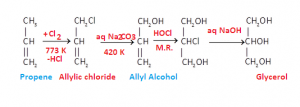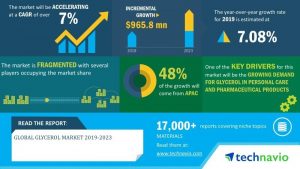A variety of economic, environmental and technical factors have encouraged industry attention on producing industrial chemicals from bio-feedstocks, rather than from crude oil derivatives. One such example is producing propylene glycol (PG) from glycerin (GLY), rather than the conventional routes starting with propylene monomer.
Related Projects: Chemicals (Organic, Inorganic, Industrial) Projects

Propylene glycol has historically been produced in commercial quantities either via the chlorohydrin process or by peroxidation, both using propylene monomer as the starting material. Both routes produce propylene oxide (PO) as an intermediate chemical, which is then hydrated to propylene glycol. The peroxidation routes have evolved from those processes (Arco Chem/Lyondell, Repsol, Shell, BASF) producing a significant amount of by-product (PO/styrene monomer, PO/tertiary butyl alcohol, PO/ methyl tertiary butyl ether), to more recent processes developed by Solvay, Dow and BASF that eliminate the by-product by using hydrogen peroxide as the oxidizing agent.
Opportunities in Glycerin Industry:
The combination of high crude oil prices and governmental subsidies to produce biofuels (bio-ethanol, bio-diesel) have resulted in an enormous increase in bio-diesel production, resulting in a glut of by-product glycerin (which represents 10% of biodiesel mass). As a result, glycerin market prices have fallen from $US 2/kg down to fuel value ($US 200/mt), or less.
Related Books: Chemical Technology (Organic, Inorganic, Industrial), Fine Chemicals
The low cost of glycerine combined with the high price of PG offers an opportunity to develop industrial scale processes converting glycerine to propylene glycol. This report presents preliminary process engineering design information and the corresponding production economics for converting GLY to PG using the Davy process and a process developed at the University of Missouri by Galen Suppes. In addition to these two processes this report also provides a detailed design of the glycerin purification section that is needed to allow these processes to take advantage of lower cost crude glycerin which is readily available form may bio-diesel production facilities.
Production and Growth of Glycerin:-
Glycerol is widely used as an excipient in many pharmaceutical products. For example, it is used in ointments and laxatives. It prevents dehydration of the body during vomiting and diarrhea. Similarly, in the personal care segment, glycerol is used in oral care, hair care, skin care products, and water-based personal lubricants. The rising demand for skin care and pharmaceutical products is expected to drive the growth of the global glycerol market during the forecast period.
Related Videos: Chemicals (Organic, Inorganic, Industrial)

The increasing demand for glycerol in propylene glycol and epichlorohydrin production will have a positive impact on the market and contribute to its growth significantly over the forecast period. This research report also analyzes other important trends and market drivers that will affect market growth over 2019-2023.
Propylene glycol, derived from glycerin, is emerging as a substitute for ethylene glycol in antifreeze products. The demand for propylene glycol is increasing in many applications such as functional fluids, unsaturated polyester resins, food, pharmaceuticals, liquid detergents, personal care, and others. It is also used as a deicing and anti-freeze agent in paints. Similarly, epichlorohydrin, which is derived by treating glycerol and hydrogen chloride, is widely used as a precursor in the synthesis of many organic compounds such as glyceryl nitrate. It is also used to manufacture tea bags, coffee filters and in water purification applications. The growing demand for propylene glycol and epichlorohydrin is expected to boost the growth of the market during the forecast period.
Conclusion:
Niir project consultancy services (NPCS) is committed to offering an unbiased and independent market research solutions to their clients. The project report by NPCS on glycerine from propylene provides all the major components of the industry and all the data is compiled after months of executive research. Each detailed project reports cover all the aspects of business, from analyzing the market, confirming availability of various necessities such as plant & machinery, raw materials to forecasting the financial requirements.